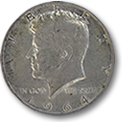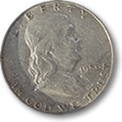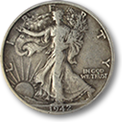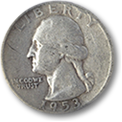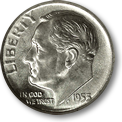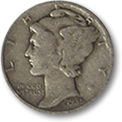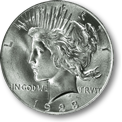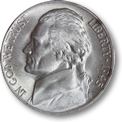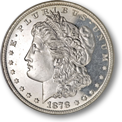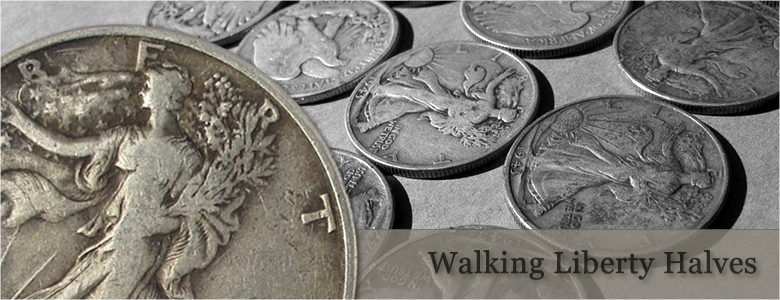
History of the Walking Liberty Halves
The Majestic Walking Liberty Half Dollar silver coin is considered by many as the most beautiful of the US half dollars ever minted. Designed in 1915, and released into circulation in 1916, it was in production until 1947. The design was so well loved that it also appears on the one-ounce Silver Eagle silver bullion coin, still in production today.The year 1916 marked a year of many changes in the US Mint Department coinage development process. A few years before the Liberty Nickel was changed and now change had been scheduled for the dime, quarter and half dollar. Technically this marked an end to the "Barber Era" a time when the coin designs were largely done by Chief Engraver Charles Barber, whose designs were now being judged as "boring".
The beauty and majesty of the Walking Liberty can be confirmed by the 50 year hiatus. It is because of its extraordinary appeal that it was brought back into circulation. This is true for no other US coin. With foreknowledge of the coming design changes US Mint Director, Robert Woolley, decided to open a competition between the nation's leading sculptors. The winner, of course, would have his designs honored by immortalizing them onto the US currency. Many Americans loved this new idea. Tired of the simplistic images produced by Barber, the excitement over the new coins drew much attention from the public. Many Americans felt this competition represented a search for the American spirit of independence and love for beauty.
Some trepidation was being experienced by the staff of the Mint Department. History tells us that Barber had a rather cantankerous reputation. The first of the American Chief Engravers for US coinage, he was known to have an arrogance that caused hostility when other artists were working on coins he felt it was "his job" to design. He also had a grudge against female sculptors and worked hard to prevent designs submitted by any prominent female artists. Still working at the age of 75, much speculation about him can be made. He died later that year, while still in office. He was replaced by his apprentice; George T. Morgan, who is the creator of the famous silver Morgan Dollar coin.
The coins designer, Adolf Weinmann, was an emigrant from Germany who arrived at the age of ten, in the year 1880. He was a student of renowned sculptor Augustus Saint-Gaudens who is also credited with having provided outstanding US coin designs.
The obverse design hosts a full length figure of Lady Liberty striding across the landscape. Stars and stripes are whipping in the breeze behind her. She walks toward the dawn of a new day, with the sun rising on the horizon. She carries branches of laurel and oak, symbolic of civil and military glory. Her hand is outstretched as a bestowal of the very spirit of liberty. On its reverse an eagle raises its wings from a mountain crag, fearless in spirit and conscious of power. Behind him springs a mountain pine sapling out of the rock, the symbol of America's emergent and growing spirit.
The patriotic themes excited and resonated with many people across the nation. Ironically, the US was about to begin preparing for Word War I, against the land of Weinmann's birth. His initials (AW) were placed directly under the tail feathers.
The 90 percent silver Walking Liberty Halves were released into circulation in late 1916. They began with mintage of 608,000 at the Philadelphia Mint, 1,014,400 in Denver and 508,000 from San Francisco. Major metropolitan newspapers praised it highly, especially in New York and Boston. Whereas these mintage numbers may seem low to some, they were comparable to the numbers released for the Barber half, as in 1916 a half dollar coin bought a big basket of groceries from any market, and was largely viewed as "a lot of money".
The circulation run for the Walking Liberty ended in 1948. At this time president Franklin D. Roosevelt had recently passed away, and the nation craved a way to honor his presidency, and show the intent to immortalize his spirit. This was the year the Franklin Half Dollar was created, and this became the very first coin to host an image of a man who was currently not president.
As one might guess, the "Walkers" are heavily collected due to popularity and craftsmanship. The appeal crosses the public sector, being gathered by the public as well as collectors seeking to complete sets. Between 1916 and 1947 over 485 million were struck into circulation that still exist today in MS65 condition or better. The complete set containing 65 varying date and mint combination's can be found for about $1000 when in average circulation condition (AG-VG for the early ones, and F and XF for subsequent years). This makes the series accomplish-able for many collectors. Coins at the higher grades and in mint state conditions will garner much higher premiums.
Some collectors begin with short sets—coins dated from 1941 to 1947, about 20 coins in all. Obtaining these in the higher grades can become very profitable. Warnings are issued for the higher grades that for some reason became subject to a weakness from the strike. On Lady Liberty's left hand, leg, head and skirt lines as well as on the reverse at the eagles breast and leg feathers. The sharply struck coins, of course, receive substantially higher rewards.
In 1918 an attempt to improve the strike quality was made. New Chief Engraver Morgan tried to sharpen the details for the strike. The attempt was repeated in 1937, and again in 1938 by the assistant engraver, John Sinnock. None of these revisions appeared to help much. These later issues still proved weak and collectors watch for wear marks on Liberty's head, on her breast, and on the reverse at the leg, breast and forward wing of the eagle.
These "Walkers" were issued rather sporadically during the 20's and 30's. These are the years for many of the key dates. A few that were minted during the "teens" are also challenging to find. The 1916 dates run about $50 bucks over silver content value for the 1916P or D in VG-8 condition. They go for over $130 if you find a 1916-S. When they were first released into circulation the mint mark could be found on the obverse, however this changed during production in 1917 which caused two types for collecting to emerge that year. The Halves that are minted on the obverse command a higher premium. This is because of the lower number produced. The 1919 coins had similar mintage's with other dates, and these prices also remain higher. The 1919-D in MS65 condition lists for a whopping $130,000, the most expensive of this series.
The most rare of all the Walkers are dated 1921 and were minted in Philadelphia and Denver in mintage runs of 246,000 and 208,000. Examples from these runs cost about two hundred dollars apiece, even for the G4. The 1921-S run had a mintage of 548,000. It is a tough search to find these coins in MS gem condition and the 1921-S in MS65 condition can retail for $105,000 according to Coins Magazine, as of March, 2006.
In the rest of the 1920's and 30' production levels never fell under a million, except the 1938- D. Many consider this a key date. The total mintage for that year was 491,600, the third lowest, by standards of production. Most G4 coins run about $100 and MS65 list at $1,550. There are very few 1919-D's in MS65 condition. Only ten of these coins have been graded, even though 669 of the 1938-D's have been.
In the 40's production boomed. Before then, production exceeded 10 million three times. From 1940 until the end of their production run, more than ten million were minted 12 times. This created some nice supplies for the collectors. The exception to this is the 46'-D, S and 47"-D when production was between two and four million for those years.
There was only one significant error emerging from the Walking Half runs. The 1946-P double die reverse. Less notable errors reported include the 1928-S large and small mint marks, the 1942-D over the S and a 1942/43 over-date stamp. Some proof-coins were also struck in 1941 without the designers initials. In all, only 74,000 Walking Liberty Half Dollar proofs were minted and all of these were 1936 through 1942. A few are matte-finish proofs from 1916 and 1917. The well struck coins do have a higher value because of the weakness problem with so many of the strikes. As noted, the repair on the design didn't go well.
The tone across the nation during the minting period of the Walker was tumultuous. People needed to have something to focus on that would help them feel good about what was happening in the country. World War I was beginning to break and Woodrow Wilson was at the nation's helm. He declared war against Germany in 1917, although fighting was taking place before this.
Inside the country there was a widening gap between the wealthy and the very poor. Headlines from the "Harper's Weekly" reported stories with headings that read "$28,000 Paid for a Salt Cellar" or "Husband and Wife found Starved to Death—Too Proud to Beg after Long Unemployment" or "Enormous Prices Paid for Old Furniture" or "Thousands Out of Employment Appeal Government for Food and Shelter".
This disparity naturally led to discontent. At the beginning of the 1916 minting process the country experienced more than 2,000 strikes and lockouts. Activists were working for six day work weeks, the woman's right to vote (they got it AFTER the black man). The public was fighting for the right to have access to birth control, education, and prohibition. Capitalism was under attack from the socialists, which led to the public outcry about suspicious initials stamped onto the 1916 mintage releases designed by John R. Sinnock. Suspicious people wrote and called into the US Mint complaining that Joseph Stalin's initials had been sneaked onto the US coinage. This continued even after the initials were made to include the "R" of Sinnock's middle name, now they wondered how the Mint had discovered Stalin's middle name (which actually began with a "V"). Finally Director Woolley issued a public statement naming the competition winning designer, John Sinnock, who eventually became an apprentice engraver.
Life had its up side during this time as well. Everyone remembers the onset of the flappers, the jitterbug and other emerging national pass-times. This was the time of prohibition, and mass transit. Networks of trains and stations made access to many parts of the Country a much simpler task than it is today. Moving pictures were showing stars such as Fatty Arbuckle, Mary Pickford, Charlie Chaplin and The Keystone Kops. A brand new "Tin Lizzie" went for $360. The president and politicians of this era knew well that coinage use and currency design was a powerful medium to use to call attention to yourself or others in the party.
Some people still unknowingly interchange the Walking Liberty coin title with the Standing Liberty title, not realizing there are two very different coins. Our national history has not done a great job of defining the difference which leaves many guessing, if contact with coins is not frequent. Coin dealers and junk silver coin collectors will surely know the difference. The designs have become some of our nations most prized, demanding a good amount of money for the most-rare when found.
Today, the walking liberty coins are highly prized because of their inherent silver content. They were made with 90 percent silver and 10 percent copper. Coin dealers and precious metals dealers call them junk silver if they have no unique numismatic value. Junk silver is regularly traded as a hedge against inflation, a way to hold value, and something that can be used for bartering in bad economic times. Learning of the histories and climates that surround our nation's currency is a deeply layered project, with much to teach us about our evolution, values and accomplishments as a nation. Coin collecting is not only a profitable and pleasurable process, it can also teach us much about our people and our past. Patriotism and the greatly symbolic images used were powerful, and people were definitely impacted when they were released into circulation.








